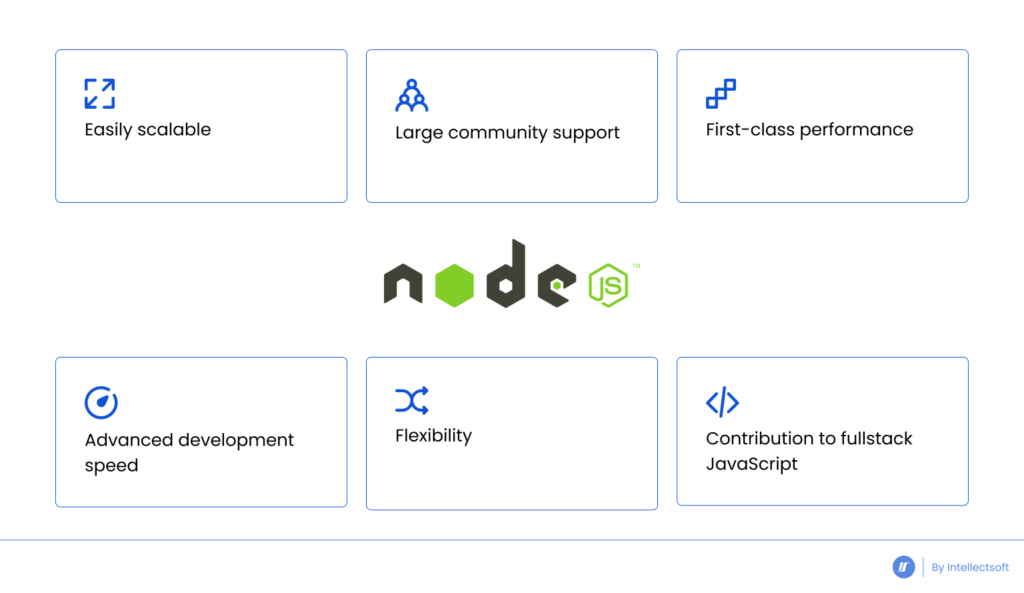Selecting the right languages, tools and platforms have a huge impact on the software's functioning – from the simplicity of its creation to the performance and efficiency it can provide. So, once you’ve decided to launch an app, you’ll probably want to consider building your stack around JavaScript – one of the most popular programming languages that are used for websites and non-browser environments as well.

And, for the backend development, programmers suggest using Node js – a cross-platform and open-source environment. In fact, this technology has become extremely popular over the last few years and, thanks to its characteristics, will continue to stand the competition in 2022 for many startups and enterprises.
In this guide, we’ll make a detailed overview of what is Node.js, its pros, and cons, yet explain the major features that will surely come in handy for you and your business.
What Is Node.js & How Does It Work?
Node.js is an open-source, cross-platform runtime environment and library for Chrome’s Javascript, that is usually applied for developing and running scalable web applications outside the client’s browser. Node.js environment is built on top of Google Chrome’s JavaScript Engine V8, which uses an event-driven, non-blocking I/O model – lightweight, more productive, and an ideal option for data-intensive real-time apps running across shared devices.
In other words, that’s not either a framework, programming language, or library, which is used for the traditional application software, Node.js is an environment for them.
Today, this environment is popular not only because of the right time and right place; it happened to be built in 2009 by Ryan Dahl. Instead, designed with real-time push-based architectures in mind, it features a large scope of innovative approaches for JavaScript server-side development.
Nowadays, Node.js is already been widely used for front-end and back-end API services development, encompassing:
- Traditional web sites
- Chatbot apps
- Single-page applications (SPA) development
- Data streaming
- IoT app development
- Social media networking (back-end development)
The Specific Features of Node.js to Know
Once you’ve reviewed the basic information about Node.js, it’s time to learn more about its potential – by reviewing the main features of this environment. This will help you to get a better idea of using Node.js, yet helps to evaluate whether or not it’s the right option you need for the software development projects.
Some of the useful functions of Node.js you should certainly pay attention to include:
- Microservices – an individual, self-contained unit that works alongside others to make up a large application. They allow different app components to be compartmentalized and managed individually, modified, and updated without impacting the application performance.
- Event-driven programming – a feature that allows getting a quick response to various forms of user engagement, including clicks or key presses. This feature is designed to detect actions once they occur to reach a more reactive and intuitive UX, and add more to the app flexibility.
However, there are 3 major features of Node.js, which helped it to gain that much popularity, and which we should certainly review in detail: Non-blocking I/O, Libuv, and Node Package Manager.
Non-blocking I/O
This feature is developed to avoid the issue of the synchronous thread (also known as the separate threads) – the situation in which a separate thread is started for each request and blocks the entire process.
Commonly, many environments help web servers to start individual threads, but Node.js allows working with single threads in turns.
Libuv
Libuv is the specific cross-platform C library that is mainly designed for Node.js environments and ensures the constant processing of the single threads with the mechanism known as an event loop.
For this purpose, the library creates a pool with up to 4 threads to be processed at the same time. In addition, it automatically sends the requests to the operating system, which significantly improves the timing. This Node.js processing model is mostly utilized on JavaScript event-based models along with the callback mechanism.
Node Package Manager (NPM)
Also called NPM, note package manager is in-built support for package management, that includes hundreds of thousands of downloadable libraries for any specific preferences and needs. NPM is mainly known as the world’s largest software registry, which is absolutely free for use and is getting larger day by day, which greatly empowers the Node.js community.
Some of the most useful NPM modules today include:
- NPM: Express.js
- NPM: Meteor.js
- NPM: Koa.js
- NPM:Nest.js
- NPM:Mongo.js
With these modules applied, you can more than surely create a powerful module that features a high performance, automates time-consuming tasks, ensures robust routing, and provides top-notch test coverage.
What Are the Advantages of Node.js Use?
Another essential aspect we should shed light on in the comprehensive guide to Node.js is the upsides and drawbacks of this environment. In this case, you’ll be more than surprised by the lucrative benefits of using Node js.

Easily Scalable
First of all, the apps based on Node.js are easily scalable, both vertically and horizontal. Vertical scaling enables adding more resources to the current nodes, while horizontal – allows adding new nodes quicker, which can greatly speed up the development process. Additionally, the Node.js apps can perfectly work with a set of microservices and modules, which makes the development process more simple and easy – a perfect option for scalable startups.
Large Node.js Community Support
Along with the millions of fans contributing to support developers across the globe, the Node.js Foundation, which was established in 2015, consists of leading enterprises such as IBM, Microsoft, Fidelity, and SAP. This means you’ll always find support among semi-minders, as well as develop and maintain any framework created.
First-Class Performance
Among many developers, Node.js is known as the powerful, feature-rich environment for developing ultra-fast-performing and scalable apps. With the event-driven architecture and non-blocking I/O tasks that can easily run on a single thread, without blocking any operations and with almost no delays. These characteristics make Node.js a resource-efficient tool that can greatly accelerate the framework speed.
Moreover, the V8 JS engine complies with Javascript code directly into the machine code, which is mostly used in Chrome and Node.js. Also, Google – the company that developed the V8 engine in 2008, continues investing heavily to improve its performance.
Advanced Development Speed
What is more, one of the best features of Node.js use is its ability to accelerate the web app development process with a variety of tools that are lightweight and easy to use. The NPM registry provides a wide range of solutions, modules, and libraries that enable the creation of more valuable apps at a lesser effort and cost. What is more, this environment helps to significantly reduce the bugs, decrease the app size and develop the app in short time frames with the reusable template.
More Flexible for the Various Software Development
For most developers, Node.js is a perfect environment for developing cross-platform apps. With frameworks like Electron, NW.js, you can now launch top-notch applications that are fully compatible with nearly any device on macOS, Windows, or Linux.
In addition to that, Node.js supports the MQTT protocol, commonly used by IoT applications, making it easy to connect to independent and third-party services, as well as prepare them for the back-end integration through different environments.
Contribution to Fullstack JavaScript
Last but not least, Node.js is a part of a robust tech stack that has proven its potential because of JavaScript – the leading programming language across the globe. As a stand-alone, it provides many benefits to the tech stack such as, for instance, the JSON module library.
When It’s Better to Avoid Node.js?
Nearly any technology today has its pros and cons, so before you start using any of those, you should ensure it’ll work best for your project. With all its benefits incorporated, there are still some cases when Node.js is not the best option to choose for the software development process.
You might encounter the other tech solutions in the following cases:
- Creating a perfect software solution. Despite the NPM modules and libraries included, the apps created with Node.js can still have bugs and poor quality in cases when the developers don’t have enough experience with using this system.
- For CPU-intensive computations. It’s better to avoid using Node js if the app server deals with heavy computations, it gets blocked because of the single-threaded quality of Node.js.
- Launching a server-side web app with a relational database. If a server-side web app has any CPU-intensive computation, it is likely to block Node.js responsiveness. Because the Relational Database is still underdeveloped, it’s better to consider the other environments to perform related functions.
- Heavy server-side processing. Due to its event-driven and non-blocking I/O node models, Node.js can block the incoming requests while the threads are working on computing processes.
Successful Examples of Implementation & Future of Node.js
To evaluate the future potential of Node.js, nothing works better than uncovering the successful use cases of this environment and the ways of its possible implementation in different industries. In the case of the Node.js environment, plenty of companies from various industries have already switched to this technology, for instance, Amazon, eBay, Netflix, Reddit, AliExpress, Paypal, and many more.

So, to define how to use Node.js effectively, let’s review some of these cases more closely:
- Because most users interacted with the network through mobile devices, in 2016 LinkedIn decided to switch to Node.js. As a result, the company has boosted its performance by nearly 20x times, empowered servers and reduced their amount from 30 to 3, and drawn its focus on app development and improvement instead of troubleshooting.
- Being one of the first companies that started using the Node.js environment in the full production stage, Uber managed to reach a productive, scalable, bug-free app that works perfectly on macOS and Android devices. This tech solution helped them not only to process billions of requests every day but also to match multiple riders to drivers in fractions of seconds.
- After implementing Node.js, Netflix has finally found a scalable solution that can process multiple requests of their users simultaneously. At the same time, they managed to use the same language for front-end and back-end processes, thus significantly saving up the startup time from 40 minutes to less than 60 seconds.
As you can see, with more than 50% of the developers using Node js in their projects over the last few years, we can make a conclusion that this tech environment will only continue to rise in 2022.
Conclusion
To sum up, Node.js is one of the leading technologies for app development today, that allows you to effectively create a first-class application for nearly any industry. After you’ve learned what is Node.js used for, defined its benefits and possible drawbacks, it becomes easier to understand whether or not this environment is the right option for you and your business.
Making up the right decision on any project development can greatly save up the time, costs, and resources on its development, that is why hiring a software development service is one of the best solutions for many companies today.
At Intellectsoft, we are always in search of the most efficient technologies and advanced approaches across different industries, all this to deliver first-class software solutions that ideally fit the objectives and needs of our clients.
Already decided to launch the software for your business?
Talk to our experts to find out in-depth insights about Node.js use and how your organization can benefit from this environment today!
